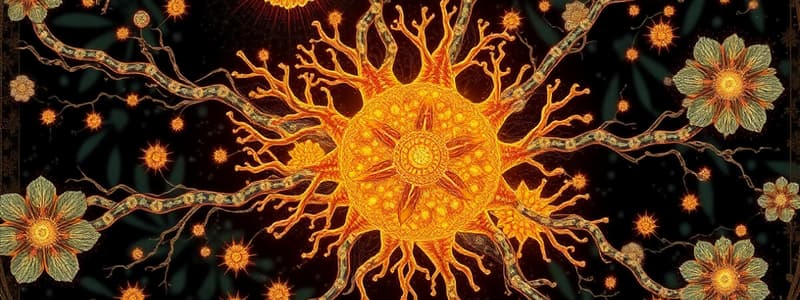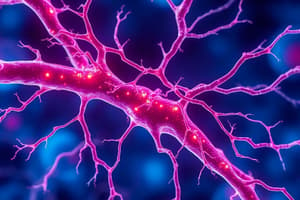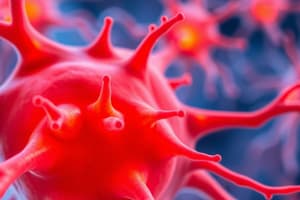Podcast
Questions and Answers
What is primarily responsible for the withdrawal symptoms associated with quitting dopamine increasing drugs?
What is primarily responsible for the withdrawal symptoms associated with quitting dopamine increasing drugs?
- The brain's adaptation to low levels of feel-good chemicals (correct)
- The brain's increased production of norepinephrine
- The sudden cessation of dopamine release
- The buildup of serotonin in the system
Which neurotransmitter is considered the main neurotransmitter of postganglionic neurons in the sympathetic nervous system?
Which neurotransmitter is considered the main neurotransmitter of postganglionic neurons in the sympathetic nervous system?
- Serotonin
- Dopamine
- Epinephrine
- Norepinephrine (correct)
What molecule is synthesized from norepinephrine in the body?
What molecule is synthesized from norepinephrine in the body?
- Dopamine
- Glutamate
- Serotonin
- Epinephrine (correct)
Which of the following statements is true regarding serotonin receptors?
Which of the following statements is true regarding serotonin receptors?
Which amino acid serves as the substrate for serotonin synthesis?
Which amino acid serves as the substrate for serotonin synthesis?
What role does norepinephrine play in mood regulation?
What role does norepinephrine play in mood regulation?
Which neurotransmitter is known to be involved in the vasoconstrictive and anti-inflammatory effects related to migraine treatment?
Which neurotransmitter is known to be involved in the vasoconstrictive and anti-inflammatory effects related to migraine treatment?
What is a function associated with glutamate as a neurotransmitter?
What is a function associated with glutamate as a neurotransmitter?
Which condition is related to low levels of serotonin?
Which condition is related to low levels of serotonin?
What is the action of amphetamines in relation to norepinephrine?
What is the action of amphetamines in relation to norepinephrine?
What are the primary categories of neurotransmitter action?
What are the primary categories of neurotransmitter action?
What is the function of choline acetyltransferase (ChAT) in the synthesis of acetylcholine?
What is the function of choline acetyltransferase (ChAT) in the synthesis of acetylcholine?
Which neurotransmitter is known for having dual action, being excitatory in skeletal muscle but inhibitory in cardiac muscle?
Which neurotransmitter is known for having dual action, being excitatory in skeletal muscle but inhibitory in cardiac muscle?
What type of receptors does dopamine primarily bind to and what effect does this binding have?
What type of receptors does dopamine primarily bind to and what effect does this binding have?
What is a significant effect of acetylcholine (ACh) levels decreasing in certain brain areas?
What is a significant effect of acetylcholine (ACh) levels decreasing in certain brain areas?
Which condition involves auto-antibodies to nicotinic acetylcholine receptors, leading to muscle weakness?
Which condition involves auto-antibodies to nicotinic acetylcholine receptors, leading to muscle weakness?
What neurotransmitter is primarily involved in the regulation of mood, cognition, and pleasure, and is associated with addiction?
What neurotransmitter is primarily involved in the regulation of mood, cognition, and pleasure, and is associated with addiction?
What is a potential outcome of high dopamine levels in an individual?
What is a potential outcome of high dopamine levels in an individual?
What is the mechanism of action for the drug donepezil in the treatment of Alzheimer's Disease?
What is the mechanism of action for the drug donepezil in the treatment of Alzheimer's Disease?
Which neurotransmitter plays a role in learning and memory and is affected in conditions like Alzheimer's disease?
Which neurotransmitter plays a role in learning and memory and is affected in conditions like Alzheimer's disease?
Flashcards are hidden until you start studying
Study Notes
Neurotransmitters
- Chemical substances synthesized in neurons that are released during neuron excitation, dependent on calcium influx
- Can create an excitatory or an inhibitory response in cells or tissues
- Action occurs in postsynaptic, post-ganglionic, or target cells (effectors)
- Act as a communication mechanism between neurons through a chemical synapse
- Photoreceptors are the only nerve cells that are active during hyperpolarization
Functional Classification
- Excitatory: depolarization
- Inhibitory: hyperpolarization (photoreceptors are the exception)
- Direct (ionotropic): neurotransmitter binds to an ionotropic receptor and opens a channel, causing an immediate response
- Indirect (metabotropic):
- Neurotransmitter binds to a metabotropic receptor
- Activates a G protein-coupled receptor
- Receptor binds to an effector protein
- Second messenger molecules (such as cyclic AMP, adenyl-cyclase, or phospholipase c) are produced
- Enzymes are activated which open channels
Neurotransmitter Inactivation
- Degradation by enzymes: from the postsynaptic cell or within the synaptic cleft
- Reuptake: by glial cells (astrocytes) or the presynaptic cell
- Diffusion: away from the synapse through the bloodstream
Acetylcholine (ACh)
- Excitatory: in skeletal muscle
- Inhibitory: in cardiac muscle
- Functional Regulation: movement, cortical excitability, heart and skeletal muscle contraction, arousal and sleep, cognition and reward
- Synthesis:
- Acetyl-CoA is derived from glycolysis products (pyruvate) and converted by the enzyme pyruvate dehydrogenase
- Acetylcholine is synthesized from acetyl-CoA and choline by choline acetyltransferase (ChAT), the rate-limiting step in the pathway
- Packaged into vesicles by a vesicular acetylcholine transporter (vAChT)
- Acetate source: Acetyl-CoA
- Choline source: reuptake after cholinesterase enzymatic degradation
Dopamine (DA)
- Functional Regulation: coordination and movement, attention, memory and learning, pleasure/ reward, arousal and sleep, behavior and cognition, inhibition of prolactin production, nausea and vomiting, inflammation and pain
- Imbalance: sleep disturbances, restless legs syndrome, psychosis, apathy/depression, ADHD symptoms
- Inactivation: monoamine oxidase (MAO) and catechol-O-methyltransferase (COMT) inactivate DA in the liver, presynaptic or post-synaptic terminal (reuptake-2)
Norepinephrine (NE)
- Function: excitatory or inhibitory depending on receptor type bound
- Indirect action via second messengers
- Synthesis pathway: same as dopamine and epinephrine (originates from the biosynthetic pathway of phenylalanine and tyrosine amino acids)
Serotonin (5-HT)
- Function: mainly inhibitory
- Indirect action: via second messengers
- Direct action: at 5-HT receptors
- Synthesis: dietary tryptophan serves as a substrate for serotonin synthesis, must know aromatic amino acid decarboxylase
Glutamate
- Function: excitatory NT
- Sources:
- Kreb’s Cycle: α-oxoglutarate is converted to glutamate by α-oxoglutarate transaminase
- Reuptake of Glu: glial or presynaptic cells or glutamine conversion
- Effects:
- May play a role in Alzheimer's disease (AD), and the loss of neurons by overexcitation and glutamate-induce activation of NMDA receptors
- Namenda, NMDA receptor antagonist, is used as a treatment for AD
- In retina: turn off or turn on the photoreceptors in retina (related to glutamate circuits), activation of photoreceptors and mGluR6
- At night, rods are on and activated by mGluR6 and cones are off at the same time.
- May play a role in Alzheimer's disease (AD), and the loss of neurons by overexcitation and glutamate-induce activation of NMDA receptors
Acetylcholine (ACh) Secretion
- Excitatory NT
- Location:
- CNS: cerebral cortex, hippocampus, brainstem
- PNS: NMJ of skeletal muscle, all preganglionic (sympathetic and parasympathetic) and parasympathetic postganglionic fibers of ANS
Cholinergic-Acetylcholine Receptors
- Nicotinic:
- N1 (NM): at the NMJ of skeletal muscle
- N2 (NN): autonomic ganglia, CNS, and adrenal medulla (for catecholamine release)
- Muscarinic:
- M1 through M5:
- Widely distributed in the CNS
- M1: autonomic nervous system, striatum, cortex, and hippocampus
- M2: autonomic nervous system, heart, intestinal smooth muscle, hindbrain, and cerebellum
- M3: mediates pupil constriction and activation of lacrimal gland secretion
- Pupil constriction: CN 3
- Lacrimal gland: CN 7
- M1 through M5:
Acetylcholine Associated-Effects
- Exposure to organophosphate insecticides: prolonged effects of ACh leading to tetanic muscle spasms
- Inhibited by botulinum toxin (Botox): bacteria Clostridium botulinum
- ACh levels decreased in certain brain areas in Alzheimer's disease
- Nicotinic ACh receptors destroyed in Myasthenia Gravis
- Atropine, anti-muscarinic cholinergic drug: used to treat medical conditions like bradycardia, uveitis, and early amblyopia in children
- Stimulates pupil dilation (mydriasis), and to paralyzed the accommodation reflex (cycloplegic), used in ophthalmic evaluation
Alzheimer's Disease (AD)
- Cholinergic neurons of the basal forebrain: involved in learning and memory and implicated in AD
- Characterized by: extensive neural atrophy in the brain cortex and hippocampal formation, and dramatic loss of cholinergic neurons in the basal nucleus of Meynert
- Symptoms: memory loss, personality changes, dementia
- Tx (replacement therapy): Donepezil (Aricept), Galantamine (Razadyne ER)
Huntington’s Disease/Chorea
- Result from: degeneration of ACh and GABA containing neurons
- Patients have: chorea (sudden, unexpected and purposeless contraction of proximal muscles) and dementia
- Atrophy of: the brain basal ganglia and lateral ventricle enlargement
- < 20 years: juvenile HD, faster progression
- Other symptoms: muscle rigidity, slow or unusual eye movements, problems walking or maintaining posture, and speech and swallowing deficits
Myasthenia Gravis
- Autoimmune syndrome: occurs in the presence of auto-antibodies to the nicotinic ACh receptors (N1/NM- related to the neuromuscular junction)
- Auto-antibodies reduce: the number of receptors in the neuromuscular junction - resulting in paresis (weakness of voluntary movements)
- Involves: extraocular and eyelid muscles (causing diploid and ptosis)
- Involves: bulbar muscles - nasal speech and jaw fatigue
- Leads to: weaker limbs proximally and stronger limbs distally
- Diagnose test: IV edrophonium (short and rapid-acting anticholinesterase drug)
- Muscle use results in fatigue (Tensilon test), if muscle strength increases likely to have myasthenia Gravis
ACh Clinical correlation Lambert-Eaton Myasthenic Syndrome (LEMS)
- Autoimmune disease at the NMJ
- Immune attack of: v-gated calcium channels at the pre-synaptic nerve endings
- Causes: a decrease of ACh release
- Weakness on: the limb muscles (weak contraction)
- 50% associated with: neoplasms (lung, breast, prostate)
- Associated with: ANS dysfunction (involuntary), most commonly dry mouth
Dopamine Receptors
- Catecholamine
- Function: excitatory or inhibitory depending on the receptor type bound
- Indirect action: via second messengers
- Secreted at:
- CNS: Sustancia nigra (pars compacta) (SNpc) and VTA of midbrain, hypothalamus (arcuate nucleus) (control energy metabolism in peripheral tissues)
- PNS: some sympathetic ganglia
- D4R: wide functions in the amygdala, hippocampus, pituitary, and RETINA
- D1R: working memory (short-term memory related to thinking and speaking)
- D3R: addiction behaviors
- Structurally: G-protein coupled receptors or adrenoreceptors that are classified as D1 through D5
- D1-like receptors -> D1R and D5R -> linked to Gs -> activated adenylyl cyclase (AC):
- Location: Limbic system, corpus striatum, thalamus and hypothalamus; mesenteric and renal blood vessels
- D2-like receptors -> D2R, D3R, D4R -> linked to Gi/Gs -> inhibits AC and Ca2+ channels, and activates K+ channels:
- Location: Limbic system, corpus striatum, thalamus and hypothalamus, pituitary gland; cardiac mm., sympathetics of the heart
Supplements that affect Dopamine levels
- Receptor AGONISTS:
- Yohimbine (Tx for erectile dysfunction, lose weight, angina)
- Ningdong granules
- Receptors ANTAGONISTS:
- L-theanine
- Ginkgo biloba (Tx improves cognitive function, blood circulation, and eye health)
- Bacopa
- Mucuna pruriens
- High DA levels: Tics, involuntary movements, euphoria, hallucinations, and psychosis
- Low DA levels: Parkinson’s disease
Dopamine effects
- "Feeling good" neurotransmitter
- L-dopa Tx in Parkinson’s disease:
- Amphetamines enhance DA levels:
- Plays a role in: cognitive, motor and neuroendocrine functions
- Increased production in schizophrenics:
- Mainly controls: movements and pleasure
- In nucleus accumbens (receive inputs from the VTA): can modulate behavior by reinforcing learning and evading aversive stimuli
Dopamine imbalance
DA Clinical correlation: Parkinson’s Disease
- Degeneration of dopaminergic neurons in the substantia nigra: reduce release of DA in caudate/putamen
- Hands tremors, rigidity, and akinesia (loss of ability to move your muscles voluntarily), dementia
- Tx: L-DOPA and carbidopa (inhibitor of dopa-decarboxylase)
DA Clinical correlations: Psychotic disorders
- Most common is schizophrenia: increase activity at dopaminergic synapses
- Tx: phenothiazines, butyrophenones (reduce the DA synaptic activity in the límbic forebrain)
Cocaine drug abuse
- Local anesthetic drug that inhibit: the reuptake of DA and NE into the nerve terminals
- Responsible for: the euphoric effects
- DA projections from the VTA to the NAcc: involve in emotional reinforcement and motivation associated with cocaine drug addiction
DA Boost by Drugs-Abuse
- The most common illicit drugs that boost dopamine levels include:
- Heroin, cocaine (crack and powder)
- Crystal meth
- Ecstasy (MDMA derivative)
- Pure MDMA
- Bath salts
- Marijuana
- LSD
- Other legal drugs that act on dopamine include: alcohol, prescription painkillers, benzodiazepines, and even caffeine
- Prolonged use of dopamine increasing drugs: are responsible for the “withdrawal” symptoms that come from quitting these drugs, because the brain becomes accustomed to these high levels of feel-good chemicals. When the brain suddenly stops getting these chemical rewards, it sends pain and sickness (nausea) causing signals to the central nervous system.
Norepinephrine (NE)
- Catecholamine
- Function: excitatory or inhibitory depending on receptor type bound
- Indirect action: via second messengers
- Pathway of catecholamines biosynthesis: dopamine, NE, and E comes from the biosynthetic pathway of the phenylalanine and tyrosine amino acids
- Location:
- CNS: Brainstem (pons)- locus coeruleus nuclei (A6 group of neurons), limbic system, some areas of cerebral cortex
- PNS: main neurotransmitter of postganglionic neurons in the sympathetic nervous system
- FEF: responsible for visual field saccadic eye movements for the purpose of perception and awareness, as well as for voluntary eye movement
NE Effects
- May play a role in the genesis and maintenance of mood
- Amphetamines enhance the release
- Catecholamine hypothesis: reduced norepinephrine activity is related to depression
- Increased NE activity: is related to mania
Epinephrine (E)
- (E) synthesis occur: in the same way as NE
- PNMT: enzyme that converts NE to E
- E origin: can be synthesized in neurons or in the adrenal medulla, and transported back to neurons or used in tissues
- C1 neurons: rostral ventrolateral medulla
- C2 neurons: nucleus tracts solitarius or solitary nucleus
Serotonin (5-HT); 5-Hydroxytryptamine
- Indoleamine
- Dietary tryptophan serves as a substrate for serotonin synthesis
- Must know: aromatic amino acid decarboxylase
- Function:
- Mainly inhibitory
- Indirect action via second messengers
- Direct action at 5-HT receptors
- Location:
- CNS: Brainstem (dorsal and medial raphe nuclei): midbrain, medulla, pons
- Send projections to:
- Hypothalamus
- Limbic system
- Cerebellum
- Pineal gland
- Serotonin is synthesized in the pineal gland, also serves as a precursor of melatonin (sleep patterns)
- Spinal cord
Serotonin Receptors:
- Receptor families from 5-HT1-5 with family subtypes
- Receptors types 1, 5, and 6 are inhibitory receptors
- Receptors types 2, 3, and 4 are stimulators receptors
- Second messenger for all families is cyclic AMP (cAMP)
Serotonin effects
- May play a role in: sleep, appetite, nausea, migraine headaches, regulation of mood, body temperature
- Severe depression and insomnia are associated with: low 5-HT levels (eg: Prozac, blocks reuptake of serotonin)
- Mania is associated with: high 5-HT activity
- Obsessive-compulsive disorder related to: a dysfunction of 5-HT
- Tricyclic antidepressant and fluoxetine (Prozac) increase 5-HT availability: to relieve anxiety and depression
- Selective serotonin receptor agonists (for 5-HT10) (eg: sumatriptan (Imitrex)) can abort migraines (due to a vasoconstrictive and anti-inflammatory effect)
Studying That Suits You
Use AI to generate personalized quizzes and flashcards to suit your learning preferences.




